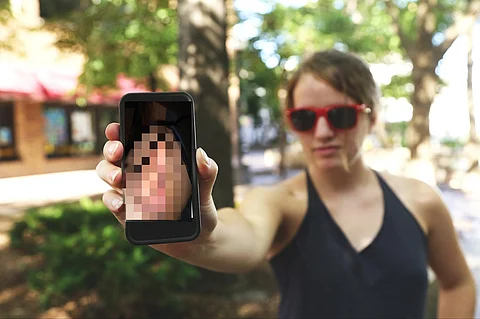

Imagine you are in a bus and using your phone or browsing online when suddenly, an image of someone’s genitals pop up on your screen.
If it’s happened to you, you’ve just been cyber-flashed.
This is exactly what happened to British national Lorraine Crighton-Smith (34) when she was commuting in a train. Someone in her vicinity sent her a photograph of a penis on her iPhone via Apple's Airdrop sharing function while she was one her way to work.
In June, New Delhi-based Scoopwhoop editor Sonali Mushahary had a similar experience. In an article she wrote for Scoopwhoop on June 17, she said a man named Sachin Jain had sent her a photograph of a penis through Facebook. Although the message had been sent on April 14, she saw it much later when she checked the folder where messages from unknown persons appear.
Sometime after the article was published, Delhi-based firm called Nauti Nati got in touch with her. Jain’s Facebook profile had listed the firm as an employer, and appeared to have read her story. Representatives of the firm said they fired him within a month of taking him on because of similar behaviour.
Speaking to The News Minute, Sonali said “The whole point was to tell the guy that he can’t just say something online and gratify himself and think he is safe because it was on a virtual medium.”
Asked why she didn’t file a complaint, she said “Firstly because, I wasn’t sure of his identity as the account did not seem genuine despite the fact that it had a picture and a few friends. The account also said he was from Delhi Public School RK Puram (Delhi), where I had done my schooling. Secondly it is too much trouble to deal with police and moreover if it is not a genuine account then it would cause collateral damage.”
Reflecting the dilemma of how to deal with online harassment as opposed to street harassment, Sonali said: “If it had been on the street, say a stalker had flashed at me, then I would I have taken action. But on the internet, it is difficult to prove anybody’s identity. And so I would think twice before filing a case. People might think I am lying if I just create hype with no concrete proof against the guy.”
Sonali says her mother warned her against pursuing the matter fearing that it could cause further harm.
After her story was published, some people called her insensitive because she didn’t care for his job. “Didn’t he care about his job before sending the picture to me?” she told The News Minute.
For her, the possibility of punishment appears to be enough. “If I want, I can still track this guy down and make him pay for it. When you know that you have the avenues to get him to pay for it is an empowering feeling by itself.” She adds.
Sonali’s case appears to be one of the few, if any at all, cases of cyber flashing reported in the media. Had she gone to the police, it is unclear whether the constable at the police station would know under what sections of the law to register her complaint.
Joint Commissioner of Police for Crime in Bengaluru Hemanth Nimbalkar says there have been cases in India similar to cyber-flashing. Such acts are punishable under Section 67 of the IT Act, which makes it an offence to publish obscene content in electronic form. He added that it could even be punished under Section 294 (performing an obscene act in public) and Section 354 (outraging the modesty of a woman) of the Indian Penal Code.
Cyber law expert Vijayshankar Na however, differs in his assessment of the power of Section 66 to penalize such an offence. In a blog post, he argues that while Section 67 dealt with obscene content, it was not foolproof.
People could send obscene content to another person without their consent, but could argue that the image was a piece of art, and therefore, use the freedom of expression as a defence. The effect of the picture on the receiver under Section 66 would not be the priority.
Before it was scrapped, Section 66A of the IT Act was meant for penalizing “offensive” content sent through electronic media. In Vijayshankar’s view, had this section still been in force, freedom of speech could not have been used as a defence by an offender in court.
What was once a revolution in communication – the separation of communication from physical travel – has now giving more avenues for people harass others, and the law is struggling to catch up.